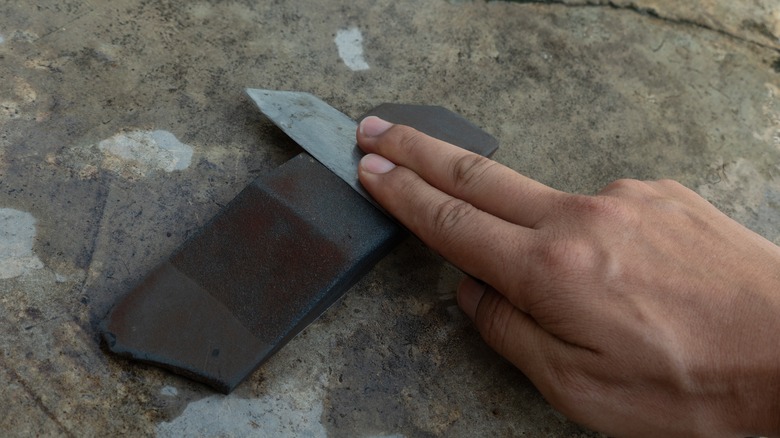Keep Your Utility Knife Blade Ready To Slice By Sharpening It In A Few Simple Steps
Getting as much use as possible out of what we buy is smart for our wallets and the planet. Utility knives are one of the tools every homeowner should have, and we tend to think of their blades as disposable. But why not squeeze as much use out of them as possible? We sharpen our scissors, tools, and kitchen knives for years of use, so let's borrow that resourcefulness to make the most of box cutters, X-Acto knives, and other toss-able blades.
Bringing your blades back up to snuff isn't the quickest process, but with the right tools and tips, it's definitely a doable DIY. What you'll need to get this done are a sharpening stone, a cutting steel, oil, and a cutting board. The kind of oil you use is up to you; plant-based oils work well, but there are also oils specially created for sharpening. If you don't have a sharpening stone, there are household staples like aluminum foil that will work, or you can even do it with nothing but a coffee mug in a pinch.
Get your blade as good as new
As you sharpen, there will be small particles of metal coming off of your blade. Ideally, take on this task outdoors, or in a woodshop. If you're working in your kitchen, clear all food away from your workspace. Set your sharpening stone on the cutting board, and hold the blade at about a 20-degree angle against the sharpening stone.
Starting on the coarse side of the stone, run each edge of your blade over the stone's surface in long strokes in one direction only (not back and forth) several times. Repeat this on the finer side of the sharpening stone. As you use the stone, periodically check the edge of your blade to monitor how sharp it's getting. Run some water over the blade and repeat the steps above; the water adds friction to the process. Next, add a bit of oil to the sharpening stone — this lubricates and cools the blade — and repeat the process with the sharpening stone.
Grab your sharpening steel and run the blade over it several times, using long strokes from the base of the blade to the tip. Just as you did with the sharpening stone, run the blade repeatedly over the steel several times at a 20-degree angle. Test your blade by cutting a piece of paper; it should cut the paper effortlessly. To keep your utility blade in top shape, use the steel frequently. You won't need to use the stone again until the blade becomes extremely dull. Rinse or wipe the blade, and it's ready to take on more jobs.

